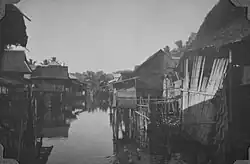Kema District
Kema | |
|---|---|
 Location of Kema within North Minahasa | |
| Country | |
| Province | North Sulawesi |
| Regency | North Minahasa |
| Villages/Sub-districts | 10 |

Kema (Kecamatan Kema) is a district in North Minahasa Regency, North Sulawesi Province, Indonesia. It is a coastal region historically tied to maritime life, bustling port activities, and cultural fusion. Today, it’s segmented into several areas named Kema I, II, and III, each maintaining vibrant fishing communities with historical relevance in maritime trade and cultural development.
Economy
Kema’s economy is primarily based on fishing and small-scale marine industries. The PLTU Sulut 3 steam power plant, located in Kema Satu Village, has contributed to local employment and energy supply. However, it has also raised environmental concerns, including pollution and ecosystem disruption. The district’s port, once a regional hub, now serves mainly local fishing operations.[1][2]
Pre-Islamic Historical Development
Before the spread of Islam, Kema was part of a regional network shaped by indigenous customs and Hindu-Buddhist influences. Archaeological evidence suggests the presence of structured settlements with roads, religious buildings, and marketplaces. These developments reflect broader Southeast Asian patterns of early civilization.[3][4]
Colonial Expansion and European Influence
In the 16th century, Portuguese and Dutch powers established a presence in Kema. Portuguese sailors built churches, fortresses, and prisons, while the Dutch later designated Kema as a free port. The intermarriage between Europeans and locals led to the formation of the Borgo community, which held special privileges under colonial rule.[5]
Demographics and Post-Colonial Transition
While Islam became dominant across Indonesia, Kema retained religious diversity due to its colonial Christian institutions and indigenous traditions. Churches remain active, and the district reflects a blend of Christian, Muslim, and local spiritual practices.[6]
References
- ^ Wenno, Leony A.; Munaiseche, Maya E. I.; Worotikan, Laela; Lahete, Sheva B.; Gunawan, Riski; Lontaan, Edna T.; Miniari, Ni Made; Anggreyno, Gregoryan; Tabuni, Yeko (2024-08-22). "Influence of the Surrounding Environment Steam Power Plant (PLTU) Kema Satu Village, Kema District, North Minahasa District". Interdisciplinary Journal of Advanced Research and Innovation. 2 (5). doi:10.58860/ijari.v2i5.59. ISSN 3031-9455.
- ^ Regency, BPS-Statistics Indonesia Minahasa Utara. "Kema Subdistrict in Figures 2019". minutkab.bps.go.id. Retrieved 2025-07-27.
- ^ "Indonesia Precolonial History - Arrival Hinduism, Islam & Europeans | Indonesia Investments". www.indonesia-investments.com. Retrieved 2025-07-27.
- ^ "Do You Know How Indonesia Was Before Islamization?". indiaherald.com. Retrieved 2025-07-27.
- ^ Marzuki, Irfanuddin Wahid (2018). "Rise and Fall of Kema Port in Sulawesi Sea Trade Routes During Colonial Period: Based on Infrastructure Data". Kapata Arkeologi. 14 (1): 89–100. doi:10.24832/kapata.v14i1.475. ISSN 2503-0876.
- ^ "History of Indonesia - Islamic influence in Indonesia | Britannica". www.britannica.com. Retrieved 2025-07-27.